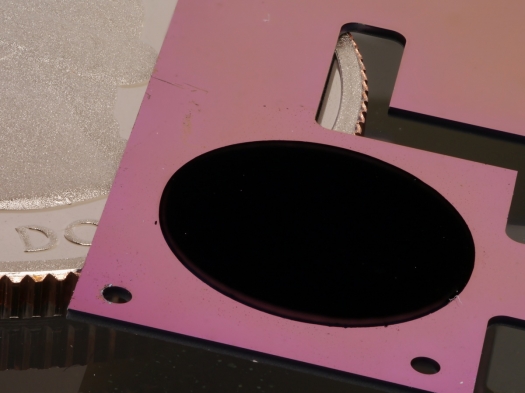Novel silicon chip simplifies laser power measurements

NIST's prototype carbon nanotube device is a silicon chip topped with circular mats of carbon nanotubes standing on end
NIST has demonstrated a chip-scale instrument made of carbon nanotubes that may simplify absolute measurements of laser power.
The device is especially suited to transmitting light signals used in optical fibres in telecommunications networks.
The diagram at the top of this story shows the circular patch of carbon nanotubes on a pink silicon backing, one component of NIST's new cryogenic radiometer, shown with a quarter for scale. Gold coating and metal wiring has yet to be added to the chip.
The radiometer will simplify and lower the cost of disseminating measurements of laser power. (Credit: to Tomlin at NIST).
The prototype device, a miniature version of an instrument called a cryogenic radiometer, is a silicon chip topped with circular mats of carbon nanotubes standing on end.
NIST says the mini-radiometer builds on its previous work using nanotubes, the world's darkest known substance, to make an ultra efficient, highly accurate optical power detector.
"This is our play for leadership in laser power measurements," project leader John Lehman says. "This is arguably the coolest thing we've done with carbon nanotubes. They're not just black, but they also have the temperature properties needed to make components like electrical heaters truly multifunctional."
National metrology institutes around the world measure laser power by tracing it to fundamental electrical units. Radiometers absorb energy from light and convert it to heat. Then the electrical power needed to cause the same temperature increase is measured.
NIST researchers found that the mini-radiometer accurately measures both laser power (brought to it by an optical fibre) and the equivalent electrical power within the limitations of the imperfect experimental setup. The tests were performed at a temperature of 3.9 K, using light at the telecom wavelength of 1550nm.
The tiny circular forests of tall, thin nanotubes called VANTAs ("vertically aligned nanotube arrays") have several desirable properties. More importantly, they uniformly absorb light over a broad range of wavelengths and their electrical resistance depends on temperature.
The versatile nanotubes perform three different functions in the radiometer.
One VANTA mat serves as both a light absorber and an electrical heater, and a second VANTA mat serves as a thermistor (a component whose electrical resistance varies with temperature). The VANTA mats are grown on the micro-machined silicon chip, an instrument design that is easy to modify and duplicate. In this application, the individual nanotubes are about 10nm in diameter and 150µm long.
By contrast, ordinary cryogenic radiometers use more types of materials and are more difficult to make. They are typically hand assembled using a cavity painted with carbon as the light absorber, an electrical wire as the heater, and a semiconductor as the thermistor.
Also, these instruments need to be modelled and characterised extensively to adjust their sensitivity, whereas the equivalent capability in NIST's mini-radiometer is easily patterned in the silicon.
NIST plans to apply for a patent on the chip-scale radiometer. Simple changes such as improved temperature stability are expected to greatly improve device performance.
Future research may also address extending the laser power range into the far infrared, and integration of the radiometer into a potential multipurpose "NIST on a chip" device.
More details of this work are described in the following papers:
"Carbon nanotube electrical-substitution cryogenic radiometer: initial results," by N.A. Tomlin et al in Optics Letters, Vol. 38, No. 2. Jan. 15, 2013.
NIST Tech Beat article, "Extreme Darkness: Carbon Nanotube Forest Covers NIST's Ultra-dark Detector," at www.nist.gov/pml/div686/dark_081710.cfm.
and
NIST Tech Beat article, "Prototype NIST Device Measures Absolute Optical Power in Fiber at Nanowatt Levels," at www.nist.gov/pml/div686/radiometer-122011.cfm.
































